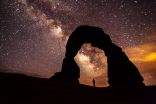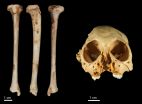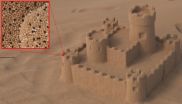(Press-News.org) Natural wonders like tumbling waterfalls, jutting rock faces and banks of wildflowers have long drawn visitors to America's national parks and inspired efforts to protect their beauty.
According to a study published Sept. 4 in Park Science, visitors also value and seek to protect a different kind of threatened natural resource in the parks: dark nighttime skies.
Almost 90 percent of visitors to Maine's Acadia National Park interviewed for the study agreed or strongly agreed with the statements, "Viewing the night sky is important to me" and "The National Park Service should work to protect the ability of visitors to see the night sky."
Acadia National Park will hold its annual Night Skies Festival Sept. 10 through 14 this year.
According to the study, led by Robert Manning of the University of Vermont, 99 percent of the world's skies suffer from light pollution and two-thirds of Americans can't see the Milky Way from their homes.
Most light threatening the National Parks comes from development, the study says. Light from cities or towns can reach parks from as far away as 250 miles.
"It's a typical story," Manning says. "We begin to value things as they disappear. Fortunately, darkness in a renewable resource and we can we can do things to restore it in the parks."
Shedding light on the dark
In addition to gauging the value to park visitors of a dark nighttime sky, the study also provides data to park managers at Acadia - and by extension, other parks - enabling them to develop visitor-driven plans for setting light pollution targets.
Mirroring a methodology Manning and his colleagues have used to understand other elements of the visitor experience, the researchers showed park visitors a series of photographs of nighttime skies at Acadia with successively more light pollution. The first photo had no pollution; each subsequent photo showed a three-fold increase in artificial light.
The larger amounts of light pollution were increasingly unacceptable to visitors, the study showed, with a threshold for an experience they no longer deemed enjoyable reached between the third and fifth photo in the sequence of eight.
With the help of specialists at the National Park Service's Natural Sounds and Night Skies Division, managers at Acadia are able to correlate that threshold of acceptability with the amount of actual illumination in the park, which they can measure, and manage toward that objective.
Inside out
Reducing light pollution requires an effort targeted both inside and outside the park, Manning said.
"Inside the park, you want to eliminate as much unnecessary light as possible," he said. "Outside, the goal is to minimize light trespass. That's more challenging, but possible."
Steps that can be taken by visitors and parks to optimize night sky viewing include the following, according to Manning:
Visitors should minimize light use, avoiding the use of headlights, flashlights and other sources of illumination as much as possible.
Most light pollution derives from older style light sources that disperse illumination horizontally rather than directionally toward the target area. Converting to LEDs and other directional lighting will enable parks and neighboring communities to dramatically reduce light pollution in the parks.
The growing popularity of astronomical tourism provides a financial incentive for towns and cities neighboring parks to reduce light pollution and should be encouraged.
Two parks have been especially successful in reducing light pollution, the study says: Acadia, which worked with the neighboring city of Bar Harbor to implement a progressive lighting ordinance, and Chaco Culture National Historical Park in New Mexico, which partnered with stakeholder groups to successfully encourage the state legislature to pass the New Mexico Night Sky Protection Act.
INFORMATION:
(Boston)--Patients with spinal stenosis (SS) experienced good short term benefit, lasting from weeks to months, after receiving epidural steroid injections (ESI).
These findings, which appear in a letter in the journal Pain Medicine, contradict a previously published New England Journal Medicine (NEJM) study that found epidural steroid injections were not helpful in spinal stenosis cases.
It has been one year since the publication of "A Randomized Trial of Epidural Glucocorticoid Steroid Injections for Spinal Stenosis." This was a large scale clinical trial evaluating ...
An international team of scientists have dated a species of fossil monkey found across the Caribbean to just over 1 million years old.
The discovery was made after the researchers recovered a fossil tibia (shin bone) belonging to the species of extinct monkey Antillothrix bernensis from an underwater cave in Altagracia Province, Dominican Republic. The fossil was embedded in a limestone rock that was dated using the Uranium-series technique.
In a paper published this week in the well renowned international journal, the Journal of Human Evolution, the team use three-dimensional ...
Tropical Storm Kevin's center was several hundred miles south-southwest of Baja California when NASA's Aqua satellite passed overhead and saw some associated high clouds streaming over the peninsula.
The MODIS and the AIRS instruments aboard Aqua captured visible and infrared images of Kevin on September 3 at 20:50 UTC (4:50 p.m. EDT). The visible image from the Moderate Resolution Imaging Spectroradiometer or MODIS instrument provided look at Kevin's clouds. MODIS showed a somewhat elongated tropical storm with a fragmented band of thunderstorms wrapping into the low-level ...
Scientists studying how a heat-loving microbe transfers its DNA from one generation to the next say it could further our understanding of an extraordinary superbug.
Sulfolobus is part of the Archaea kingdom - a single-cell organism similar to bacteria - which was isolated in hot springs on the island of Hokkaido, Japan.
Some Archaea live ordinary lives in mundane environments such as lakes, seas and insect and mammal intestinal tracts, while others live extraordinary lives pushed to extremes in incredibly harsh habitats such as deep sea hydrothermal vents, volcanic ...
"Objects of granular media, such as a sandcastle, consist of millions or billions of grains. The computation time needed to produce photorealistic images amounts to hundreds to thousands of processor hours," Professor Carsten Dachsbacher of the Institute for Visualization and Data Analysis of KIT explains. Materials, such as sand, salt or sugar, consist of randomly oriented grains that are visible at a closer look only. Image synthesis, the so-called rendering, is very difficult, as the paths of millions of light rays through the grains have to be simulated. "In addition, ...
Nowadays, internet auctions play an important role in online trading. No matter whether you want to buy a hedge trimmer or an antique pocket watch - unlike purchases by a click at a fixed price, online auctions provide the atmosphere of a competition for the auction object. Whoever perceives the competition of real contenders, e.g. by avatars or photos on the screen, wishes to stay in the race - and increases his bid. This is a result of a KIT study with more than 450 test persons.
Online auctions combine shopping with entertainment, fun, and excitement. This is the ...
Action to prevent tooth decay in children, such as supervised tooth brushing and fluoride varnish schemes, are not just beneficial to children's oral health but could also result in cost savings to the NHS of hundreds of pounds per child, so says a leading dental health researcher.
Professor Elizabeth Kay, Foundation Dean of the Peninsula Dental School from Plymouth University Peninsula Schools of Medicine and Dentistry, has carried out the first economic evaluation of public health measures to reduce tooth decay in children at high risk, in association with the National ...
When a jogger sets out on his evening run, the active movements of his arms and legs are accompanied by involuntary changes in the position of the head relative to the rest of the body. Yet the jogger does not experience feelings of dizziness like those induced in the passive riders of a rollercoaster, who have no control over the abrupt dips and swoops to which they are exposed. The reason for the difference lies in the vestibular organ (VO) located in the inner ear, which controls balance and posture. The VO senses ongoing self-motion and ensures that, while running, ...
Patients with cancer of the esophagus--also known as the gullet--are often given chemo- or radiotherapy, with the aim of shrinking the tumor before it is surgically removed. Increasingly positron emission tomography (PET) is being used to monitor the size of the tumor during the treatment. To date, however, no benefit for patients has ensued, as Milly Schröer-Günther and co-authors show in an original article in the current issue of Deutsches Ärzteblatt International (Dtsch Arztebl Int 2015; 112: 545-52).
PET is an imaging technique that makes a tumor in ...
Despite continued medical advances, infectious diseases kill over 10 million people worldwide each year. The ecological complexity of many emerging disease threats--interactions among multiple hosts, multiple vectors and even multiple parasites--often complicates efforts aimed at controlling disease. Now, a new paper co-authored by a University of Colorado Boulder professor is advancing a multidisciplinary framework that could provide a better mechanistic understanding of emerging outbreaks.
In a study published today in the journal Science, researchers demonstrate how ...




